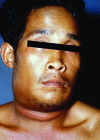Anthrax of the gastrointestinal tract
- PMID: 12095428
- PMCID: PMC2730335
- DOI: 10.3201/eid0807.020062
Anthrax of the gastrointestinal tract
Abstract
When swallowed, anthrax spores may cause lesions from the oral cavity to the cecum. Gastrointestinal anthrax is greatly underreported in rural disease-endemic areas of the world. The apparent paucity of this form of anthrax reflects the lack of facilities able to make the diagnosis in these areas. The spectrum of disease, ranging from subclinical infection to death, has not been fully recognized. In some community-based studies, cases of gastrointestinal anthrax outnumbered those of cutaneous anthrax. The oropharyngeal variant, in particular, is unfamiliar to most physicians. The clinical features of oropharyngeal anthrax include fever and toxemia, inflammatory lesion(s) in the oral cavity or oropharynx, enlargement of cervical lymph nodes associated with edema of the soft tissue of the cervical area, and a high case-fatality rate. Awareness of gastrointestinal anthrax in a differential diagnosis remains important in anthrax-endemic areas but now also in settings of possible bioterrorism.
Figures



Similar articles
-
GI anthrax: report of one case confirmed with autopsy.Med Sci Monit. 2002 Sep;8(9):CS73-6. Med Sci Monit. 2002. PMID: 12218950
-
Primary involvement of pharynx and peyer's patch in inhalational and intestinal anthrax.PLoS Pathog. 2007 Jun;3(6):e76. doi: 10.1371/journal.ppat.0030076. PLoS Pathog. 2007. PMID: 17542645 Free PMC article.
-
Oropharyngeal anthrax.J Laryngol Otol. 1985 Dec;99(12):1293-5. doi: 10.1017/s002221510009856x. J Laryngol Otol. 1985. PMID: 3934300
-
Bacillus anthracis as an agent of bioterrorism: a review emphasizing surgical treatment.Ann Surg. 2002 Jul;236(1):9-16. doi: 10.1097/00000658-200207000-00004. Ann Surg. 2002. PMID: 12131080 Free PMC article. Review.
-
New insights into gastrointestinal anthrax infection.Trends Mol Med. 2015 Mar;21(3):154-63. doi: 10.1016/j.molmed.2014.12.003. Epub 2014 Dec 19. Trends Mol Med. 2015. PMID: 25577136 Free PMC article. Review.
Cited by
-
Anthrax lethal toxin and tumor necrosis factor-α synergize on intestinal epithelia to induce mouse death.Protein Cell. 2024 Feb 1;15(2):135-148. doi: 10.1093/procel/pwad050. Protein Cell. 2024. PMID: 37855658 Free PMC article.
-
Human Anthrax: Update of the Diagnosis and Treatment.Diagnostics (Basel). 2023 Mar 10;13(6):1056. doi: 10.3390/diagnostics13061056. Diagnostics (Basel). 2023. PMID: 36980364 Free PMC article. Review.
-
Participatory mapping identifies risk areas and environmental predictors of endemic anthrax in rural Africa.Sci Rep. 2022 Jun 22;12(1):10514. doi: 10.1038/s41598-022-14081-5. Sci Rep. 2022. PMID: 35732674 Free PMC article.
-
High Case-Fatality Rate for Human Anthrax, Northern Ghana, 2005-2016.Emerg Infect Dis. 2021 Apr;27(4):1216-1219. doi: 10.3201/eid2704.204496. Emerg Infect Dis. 2021. PMID: 33754993 Free PMC article.
-
Outbreak of gastrointestinal anthrax following eating beef of suspicious origin: Isingiro District, Uganda, 2017.PLoS Negl Trop Dis. 2020 Feb 27;14(2):e0008026. doi: 10.1371/journal.pntd.0008026. eCollection 2020 Feb. PLoS Negl Trop Dis. 2020. PMID: 32106229 Free PMC article.
References
-
- LaForce FM. Anthrax. Clin Infect Dis. 1994;19:1009–14. - PubMed
-
- Jaax NK, Fritz DL. Anthrax. In: Connor DH, Chandler FW, Manz HJ, Schwartz DA, Lack EE, editors. Pathology of infectious diseases. Stamford (CT): Appleton & Lange; 1997. p. 397–406.
-
- Viratchai C. Anthrax gastro-enteritis and meningitis. J Med Assoc Thai. 1974;57:147–50. - PubMed
-
- Kunanusont C, Limpakarnjanarat K, Foy JM. Outbreak of anthrax in Thailand. Ann Trop Med Parasitol. 1990;84:507–12. - PubMed
MeSH terms
LinkOut - more resources
Full Text Sources
Medical
Molecular Biology Databases

